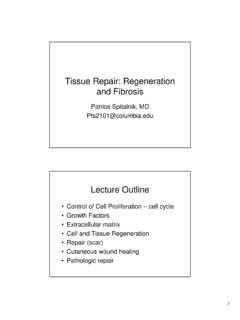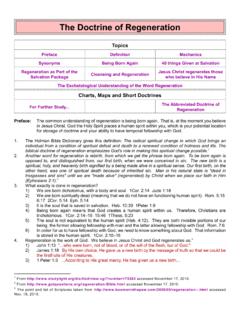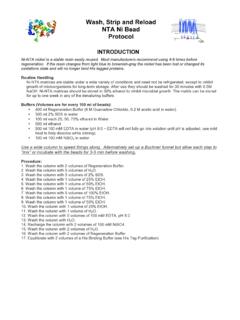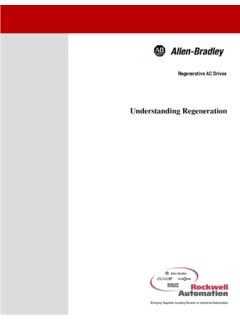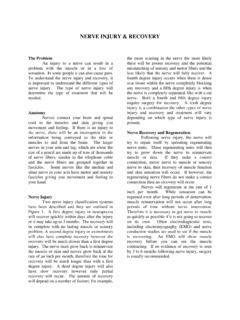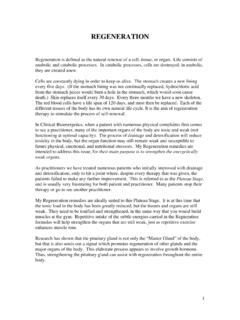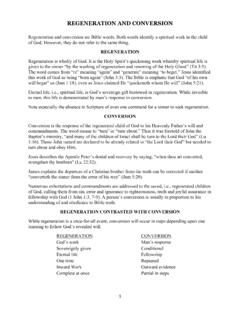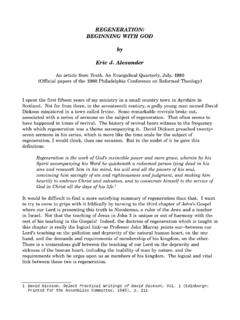Transcription of On Arachnid Regeneration - Tarantula
1 On Arachnid Regeneration & Cosmic Spider Sperm Robert Gale Breene III College of the Southwest, Carlsbad, New Mexico USA The ability to regenerate lost appendages in animals is not rare, nor is it all that common. In most groups of animals with regenerative powers, only certain parts of the body can be regenerated, like the legs or tail. Others are super-regenerators. With many sea stars (starfish) not only can any part of a missing arm be regenerated, but if enough of the arm is left, the entire sea star can be regenerated from the piece of arm. In fact, many sea stars reproduce by simply splitting in two, with each piece growing back the missing parts. Other organisms make sea stars seem like regenerative wimps. Many large freshwater planarians (flatworms) practice architomy, a form of asexual reproduction where the animal simultaneously fragments into several pieces; each piece growing back into a fully functional flatworm.
2 The key to Regeneration is in cell differentiation. Most animal cells differentiate early in the embryonic development. In the rapidly growing zygote after fertilization, groups of cells are assigned their job in the organism early on. Liver, lung, nerve and the rest of the many other types of cells differentiate and remain locked into whatever type of cell they have become. A lung cell won t give rise to a heart cell and so on. In the case of the flatworms, when cut in two, the adjacent epidermis (skin) quickly covers the wounded regions. Shortly, a group of undifferentiated, or totipotent cells called a blastema forms underneath the new epidermis. The blastema will differentiate into all the cells types needed to reconstruct the missing parts. How the blastema forms is not known. It may be induced to form by other cells, such as muscle cells through some process of dedifferentiation (reversion).
3 It could come from a pool of undifferentiated cells maintained in scattered regions throughout the body. Flat worms can be cut into several pieces, each regenerates the complete worm if the segment is large enough. Pockets of undifferentiated cells are known to exist in other animals. Sponges have undifferentiated cells called archeocytes that can regenerate lost tissues. Cnidarians (jellyfish, corals, sea anemones, hydras and others) have undifferentiated interstitial cells packed in under their epidermis. Appendage Regeneration In Arachnids Many species of Opiliones (harvestmen, one of 38 families [Phalangiidae] is called daddylonglegs) are known to practice autotomy (the ability to voluntarily toss off their legs). However, there are no reports I m aware of that they also have the ability to regenerate the lost legs.
4 In scorpions, compete Regeneration of appendages is either rare or non-existent. They have been known to regenerate parts of legs, but in a non-methodical way. For example, if an immature scorpion lost all of a leg past the femur, it won t regenerate the complete leg, but it may regenerate a leg segment, such as the tarsus at the site where the leg was lost. As for the other Arachnid orders, information just isn t available. From the limited sources I have, it s unlikely Regeneration occurs in the remaining orders such as whipscorpions, tailless whipscorpions, pseudoscorpions and the rest. Regeneration may occur in mites and ticks (Acari), but I have no sources that can confirm or deny this. I wish they d place the Acari in a class by itself outside of the arachnids, so I d only rarely have to mention them again.
5 For, as we all know, NOBODY in their right mind likes mites and ticks. Anybody that may think the statement above is a little like the pot calling the kettle black, certainly won t be reading this. Appendage Regeneration In Spiders Appendage Regeneration in spiders capable of the process is not limited to the legs only. They can regenerate the pedipalps, chelicerae, endites, the labium and spinnerets also. Apparently, not all spiders can autotomize their legs, as was reported for a few orbweavers (Araneidae). According to Foelix (1996), if a leg is not completely lost, just a few segments at the end, the missing segments supposedly regenerate at the end of the injury in certain spider species, although I ve never seen this. Also, Randall (1981) claims that widow spiders cannot replace the leg if it is completely autotomized. It can only regenerate the leg if an incomplete piece is lost.
6 After all the thousands of Latrodectus I ve raised, I can t think of a single instance where any of them lost legs. In order for a spider to regenerate a leg, it must have at least one molt remaining in the life cycle. For all adult males and most adult female spiders, Regeneration is a moot point since they don t survive the ultimate instar (mature adult). The adult females of many of the 15 orders of Mygalomorphae and some of the more advanced Araneomorphae do go through postulimate molts. Autotomy is a voluntary process. Bonnet (1930) found that anesthetized spiders could not toss off their legs. Except for some members of one family (Linyphiidae) the normal separation point for autotomy is between the coxa and the trochanter. In certain linyphiids, the separation point is between the patella and the tibia. Spider External Anatomy.
7 The Autotomy Process When the spider decides it s time to lose a leg, it jerks the coxa up, causing a pressure tear in the membrane between the coxa and trochanter. A muscle running into the leg from the coxa separates from the trochanter and snaps back into the coxa. Other muscles attached to a thickened areas on the margins of the interior of the coxa on the joint membrane pull toward each other, closing the wound opening. Blood pressure makes the joint membrane bulge outward, which also aids in closing the wound. Bonnet (1930) claimed that an autotomized leg will only be regenerated if it is lost in the first quarter of the intermolt period. This may or may not be true for most spiders, but probably is not be appropriate for tarantulas. Too many cases of Regeneration have been reported when the Tarantula was clearly past the first quarter of an intermolt period.
8 After autonomy, a complete, new leg forms in the old coxal cavity. There s little space in the coxa, so the new leg is extremely folded and compacted internally. After the next molt, the new complete leg will be smaller and thinner than the old leg until the next molt, or the one after that. With tarantulas, how much smaller is highly variable. Some new legs come out nearly the length and girth of the lost leg. Others may be as small as a third the size or less of the lost leg. Forced Autotomy When a Tarantula gets a bleeding leg injury, the first action that pops up in the minds of most keepers is to stop the bleeding. Using nail mender, stopping the bleeding only is appropriate for small puncture wounds. With more serious leg injuries involving crushing or tearing, the leg should be removed using forced autonomy and the stump double coated with nail mender.
9 A damaged leg, once the bleeding is stopped, doesn t risk the tarantulas health until the next molt. Because of the damage, it s unlikely the Tarantula will be able to pull the new leg from the old exoskeleton. This could lead to the death of the Tarantula if it can t escape its old exoskeleton, or force it to autotomize the leg during the molt. Since molting is probably not the best time for autotomy, it s probably wise to remove damaged legs long before a molt. Removal of a leg involves firmly grabbing the femur (no other leg segment, only the femur) with forceps and pulling up rapidly and forcefully. I know this sounds horrible to many of you, but try to grin and bear it; it s best for the continued health of your Tarantula . Cosmic Spider Sperm!?! Recently, I was reading Raven et al. (1999) Biology of Plants making notes for one of my classes (yes, they let me teach botany too) when I read something that would help spice up the title of this article.
10 In a figure caption illustrating flagella, it declared Virtually all eukaryotic flagella have the same this same internal structure, which consists of an outer cylinder of nine pairs of microtubules surrounding two additional microtubules in the center. The authors are botanists, so we might forgive them for the mistake, but this just ain t so. Prokaryotic cells are cells seen only in primitive bacteria and the like. Everything else possesses eukaryotic cells; from spiders, to mammals, to plants. Every flagellum of eukaryotic organisms studied so far has the standard nine pairs of microtubules surrounding a pair of microtubules except for a single order of animals. Spiders. The flagella of spider sperm apparently decided, forget the path less traveled, let s go on one never walked before.
